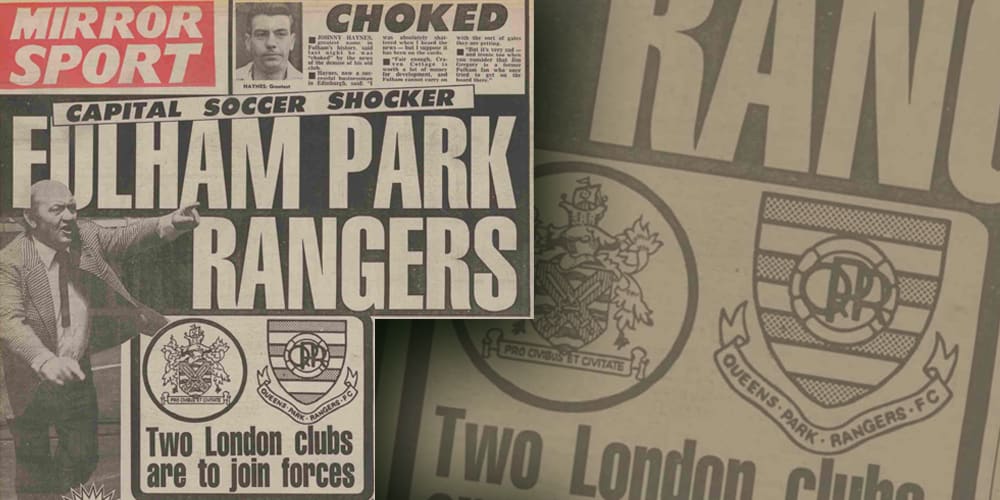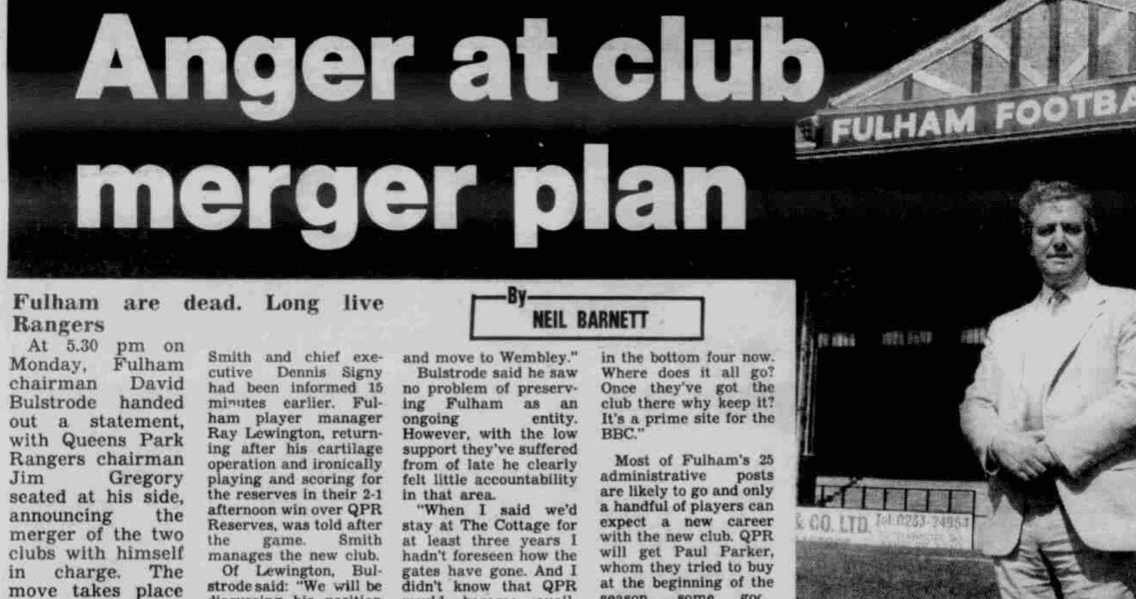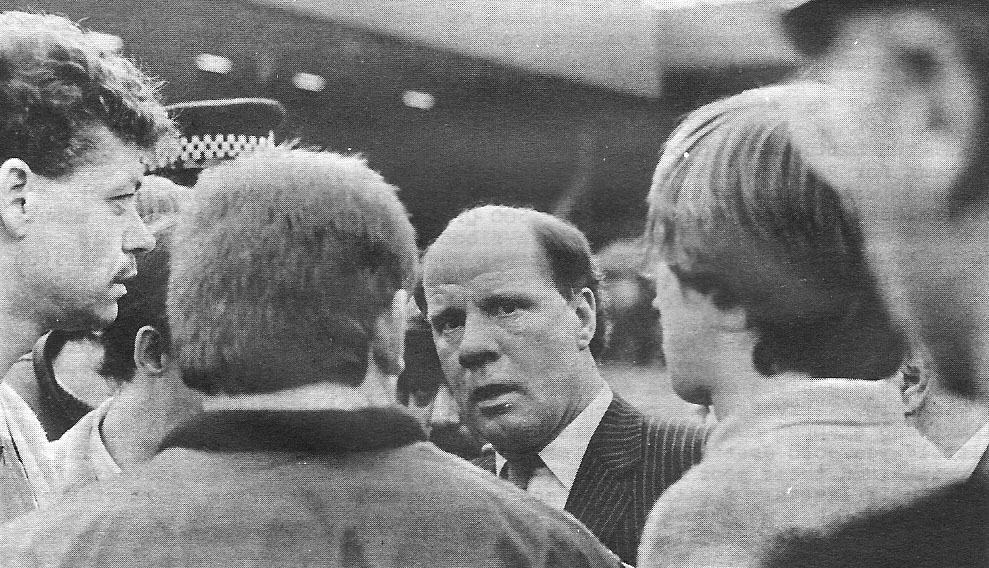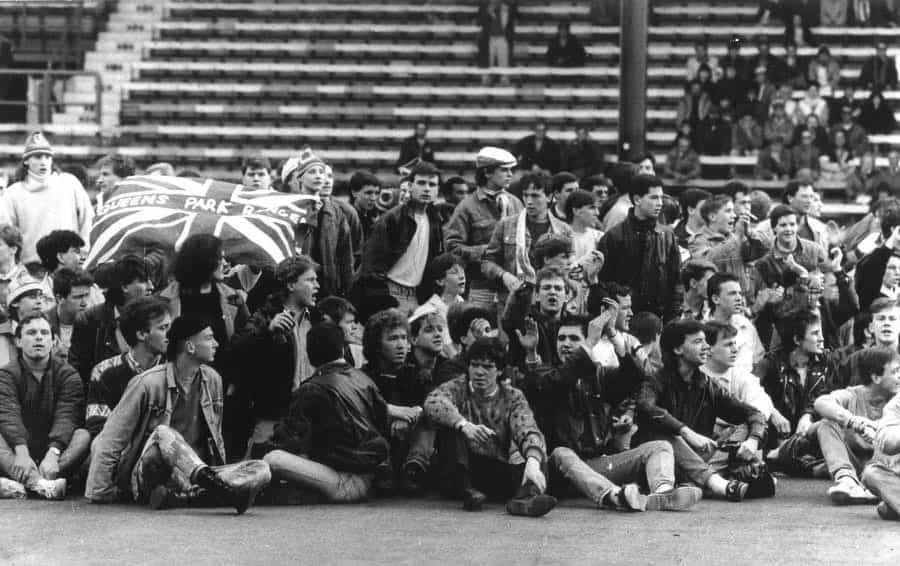Thirty-five years on: How QPR and Fulham fans stopped the merger

With Fulham and QPR currently in the thick of the Championship promotion race it seems hard to reconcile that 35 years ago this week, fans of both were fighting to keep their clubs alive.
English football in the 1980s is widely acknowledged as a dark era for the sport in this country.
The fire at Bradford City’s Valley Parade, Heysel, Hillsborough and the ban on English clubs from European competition are dark bullet points in an essay on the game from that period.
There was also the spectre of hooliganism that lingered over domestic football leading to a highly-controversial plan tabled by Margaret Thatcher’s government that would have made it law for fans to carry an ID card for the right to attend a football match.
Luton Town – then a top-flight club – went even further, banning away fans from Kenilworth Road between 1986-87 and 1990-91 following violent scenes during a FA Cup tie with Millwall.
But looming in the background of these well-documented problems was the threat of mergers faced by clubs as property developers sized-up prime London real estate.
The first idea of this type was conceived in 1982 by the corrupt media mogul Robert Maxwell, then the owner of Oxford United, who agreed with three members of the Reading board to amalgamate the two clubs and create Thames Valley Royals.
Protests from fans helped thwart the project, but 40 miles down the M40, plans to merge Fulham and QPR were percolating.
On February 24, 1987 Marler Estates, fronted by the flamboyant Fulham chairman David Bulstrode, announced at a joint press conference with QPR owner Jim Gregory the purchase of Rangers and Loftus Road with plans to merge the two clubs.

Fulham Park Rangers was mooted as a name for the new club which would initially play top-flight matches at Loftus Road and be managed by QPR boss Jim Smith, with Craven Cottage to be sold off for a luxury Thameside development site.
Fulham, then a Third Division club, and QPR, well established in the First Division, would cease to exist in their current forms.
Marler also owned Stamford Bridge, which had been earmarked as the new club’s long-term home in a potential ground-sharing agreement with Chelsea.
The announcement saw furious Fulham and QPR supporters join forces to oppose the move, but in an era before social media, plans to convey their opposition required newspaper column inches and TV and radio air time.
Fulham’s cause had the benefit of well-known figures of the time in actor Dominic Guard, his wife Sharon Duce and her co-star in the hit BBC drama Big Deal, Ray Brooks, which pulled in several million viewers each week.
Guard, a lifelong Fulham fan, had appeared in a number of high-profile 1970s films including Picnic at Hanging Rock, The Count of Monte Cristo and had the name to help garner publicity.
“We’d got mobilised a few years earlier as at one game we had a crowd of under 3,000 on a wet night at home to Carlisle and that was the moment I thought ‘I’ve had enough of this,'” Guard recalled.
“The club was like a twitching corpse under the ownership of Ernie Clay.
“So we had in place a protest group and were a few years down the line and when Clay sold to Marler Estates and Bulstrode we were good to go.
“We had re-established the Fulham Supporters Club under myself another fan, Brendan Gleeson, who I met for the first time at that Carlisle game because he was walking around as enraged as I was and it was the coming together of two angry people.
“So when Bulstrode announced Fulham Park Rangers we all thought he had been smoking a crack pipe and he just couldn’t understand why Fulham fans didn’t want it.
“The man was so out of touch and only interested in making an awful lot of money.”
Match of The Day host and former Fulham player Jimmy Hill also added his support to Fulham’s fight, headlining a fiery meeting at Hammersmith Town Hall alongside the Whites’ former manager Malcolm MacDonald.
“I went in to the council and explained what we were doing and the woman there asked me if we wanted to use the town hall,” Guard said.
“I had spoken Jimmy Hill once or twice, but wouldn’t say I knew him.
“The meeting was pretty exciting. There were fans from other clubs there and a general feeling of being together as it was a feeling of ‘If we don’t stand up for this club, it could be us next.'”
Although the QPR fans lacked the so-called star power, they made up for it with a swift but highly successful campaign that just days later dominated the sports reports both on TV and radio and the back pages of the Sunday newspapers.
Trevor Kingham, a newsagent from Edgware, a south London-based lorry driver Dave Thomas, and Kim Walsh, a Rangers-supporting solicitor, were front and centre of plans in W12 to take on Bulstrode.

“It was about three days after news had broken about the plans, and I was scouring the Evening Standard for any more information about it,” said Thomas, whose long-standing Kick Up The R’s magazine was born from the fall-out from the planned merger.
“There was a report saying QPR and Fulham fans were going to meet at a pub in Vauxhall on Thursday night and discuss plans to organise a protest that weekend.
“At the time, the only thing I had ever written was a betting slip, and I had never been involved in any protest or campaign in my life, but somehow this was different.
“I was studying a road management course at night school at the time and it was getting very close to my final exam, but I had to decide ‘Do I go the class that evening or go to this meeting?’ – and QPR won out.”
At the meeting, passionate speeches were made by fans from both clubs and there was also a rousing address from a Crystal Palace supporter whose club had been linked to a merger with Wimbledon.
The meeting resulted in a plan to synchronise protests that Saturday when Rangers were playing Manchester City and Fulham hosted Walsall.
“I turned up at the pub and there were QPR faces that I recognised and we were introduced to the Fulham fans who, it transpired, were fairly well known,” Thomas said.
“But more importantly, they were highly-organised, they had clippings in folders and knew what they were doing and had formed a working committee.
“We were just some fans who went home and away but vaguely knew each other.
“By the end of the night I got talking to someone at the bar called Kim Walsh and she was a solicitor and we realised that we had to do something ahead of the Manchester City game that Saturday.
“So I went sick the following day from work and spent the day getting some leaflets printed and we had 10,000 made up overnight at a high-street copy shop.
“On the Saturday we arrived at the game early to hand them out and when we got there, somebody had commandeered a flat-bed lorry and run up some banners and flags and this rag tag band of QPR fans drove around the area to publicise the cause.”
It was during this journey that plans were finalised by Kingham for QPR fans to delay the start of the game and stage a sit-in on the centre circle.
“There was me, Steve Russell, Vic Stevenson, a bloke called Tim Upton – he was very vocal – Trevor and his brother Peter and about a dozen others on the back of this lorry, and we went on down to Fulham,” said long-time Rangers supporter Joe Hylton.
“Fulham weren’t getting the support they do now and were only averaging three or four thousand down there.
“But when we arrived, there were over 500 fans gathered on Stevenage Road and they greeted us like long, lost brothers even though the lorry was covered in Rangers scarves and we there were loads of us in Rangers shirts.”
Guard recalls a similar feeling of togetherness when he made the opposite journey later that day to meet QPR supporters.
“I remember going up to the Springbok pub and I was wearing a Fulham badge and these two bouncers advised me to take it off,” he said.
“But I said, ‘No, I’m alright, I’m meeting some QPR fans in here’ and I remember thinking ‘I must be nuts.’
“But I was introduced to them by my contacts and they were all surprisingly very kind to me as they probably all felt sorry for me!”
Just before kick-off at Loftus Road over 300 fans raced onto the pitch as the referee led the teams out.
But it wasn’t to universal acclaim, with some members of the crowd booing the fact the game had been delayed with the matchday PA announcer accusing the protestors of ‘not being real fans’.
Manager Jim Smith and police officers also came on to the field and tried to persuade the supporters to leave, but to no avail.

“Trevor had it all worked out,” said Hylton.
“He told us ‘Stay on the pitch for at least 20 minutes, longer if possible. That way we’ll get maximum news coverage’.
“He said ‘Less than a 20-minute stoppage won’t be worth it, we have to delay the football pools results at 5pm.’
“For me I had to really think about it because I was working as a bus driver at Westbourne Park at the time and had gone on the sick to help with the protest, so the last thing I needed was to be seen on the telly or in the newspaper, but it had to be done.
“Jim Smith came out and said ‘Come on lads, we have to play the game or we will get done by the FA’ and I remember saying to him: ‘Jim, you look after the team and we’ll look after the club’.
“But it was Trevor who did most of the talking to Jim and the police and it was all very respectful but they understood where we were coming from.
“After about 25 minutes we got off the pitch and as the newspapers showed the next day, we achieved what we set out to do.”
The fall-out from the Loftus Road protests led to the formation of the QPR Loyal Supporters Association (LSA) led by Kingham, which immediately saw over 3,000 members sign up – something Thomas believes put Rangers officials on the back foot.
“That message over the PA system during the demonstration caused a huge amount of anger and resentment,” Thomas said.
“There was also a lot of anger directed at the official QPR Supporters Club because they were almost impotent really.

“I wouldn’t say they were supportive of the merger, but they were simply there to organise coaches to away matches and I think it was their lack of action which prompted the formation of the LSA.
“Everything we as QPR fans did was spontaneous and off-the-cuff, but it worked.
“The one thing that sticks out in my mind was after it had all gone down after the game and everyone had gone home, we went to pick up a load of discarded leaflets so we couldn’t be accused of littering. But we couldn’t find a single one.
“That has always stuck with me. It was astonishing. The support we had from people was incredible.
“We were the ones that got the headlines in the Sunday papers and it was seen as QPR fans losing their club and not a case of becoming stronger because we had taken over Fulham.
“If we were to become Fulham Park Rangers, you knew it would eventually just become Fulham, so it would have been QPR that would have died out not Fulham.
“Although it was a hugely important issue, it was also a hugely exciting time as well – all of us bonding together to try and save QPR.”
With the Football Association now spooked by media coverage of the protests, their initial receptiveness to the merger diluted and a few days later Thomas and Walsh were contacted by QPR and invited to sit down with Bulstrode.
“Kim and I met at the ground and taken to what was termed as a ‘top-secret location’,” Thomas explained.
“That secret location turned out to be a house close to The Loft end of the ground, which apparently QPR own.
“We met Bulstrode and basically put the case against the merger and I think he saw the strength of feeling against it.
“Marler Estates then did an about-turn and said there would be no merger and the two clubs would exist as separate entities.
“It was a huge deal really, because unlike the idea that was floated in 2001 by Chris Wright to merge with Wimbledon, which was never a reality, this certainly was something that very nearly happened.”
Bulstrode continued as chairman of QPR, while Fulham were sold to a consortium led by Jimmy Hill and bankrolled by the Muddyman family, and remained tenants at Craven Cottage.
Despite the initial opposition to his arrival, Bulstrode did manage to win over much of the QPR fan base before he died from a sudden heart attack in September 1988, with 24-year-old Richard Thompson handed the reins of the club before it was sold to Chris Wright in 1996.
Trevor Kingham passed away in 2011 aged just 60 and a Kick Up The R’s remains a staple feature of home games at Loftus Road and now in its 35th year of publication.
Fulham, under Hill’s stewardship, were due to be evicted from their traditional home at the conclusion of the 1992/93 season, leading to the formation of the Fulham 2000 campaign, set up by supporters and launched by club legend Johnny Haynes.
But a stay-of-execution was given just before the bulldozers were due to move in to Craven Cottage after Cabra Estates, had who had taken over Marler, went into liquidation.
The ground finally returned to Fulham’s hands when Harrods owner Mohamed Al-Fayed purchased the club in 1997.
“We could never have gauged that someone with that kind of money would come in to buy Fulham,” said Guard, who now works as a child psychotherapist.
“Al-Fayed came in and says he saved Fulham Football Club because they were getting 2,000 crowds when he took over, which is not true.
“The team had been promoted and they were getting about 12,000 with an exciting team.
“But there was a plan on the table that Craven Cottage was going to be turned into a 15,000 all-seater ground with flats built around it – and that is something Al-Fayed prevented from happening.”
